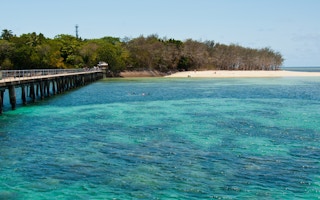Australia’s Academy of Science says an Australian government draft plan to protect the Great Barrier Reef will not prevent its decline.
The group said the Reef 2050 Long-Term Sustainability Plan failed to address key pressures on the reef including climate change and coastal development.
Much bolder action was needed, said Academy Fellow Professor Terry Hughes.
“The science is clear, the reef is degraded and its condition is worsening,” said Prof Hughes.
“This is a plan that won’t restore the reef, it won’t even maintain it in its already diminished state,” he said in a statement released on Tuesday.
“
It is also more than disappointing to see that the biggest threat to the reef - climate change - is virtually ignored in this plan
Fellow Professor Terry Hughes, Australia’s Academy of Science
“It is also more than disappointing to see that the biggest threat to the reef - climate change - is virtually ignored in this plan.”
Public submissions on the draft plan - an overarching framework for protecting and managing the reef from 2015 to 2050 - closed on Monday.
The plan will eventually be submitted to the World Heritage Centre in late January, for consideration by Unesco’s World Heritage Committee mid-next year. Unesco has threatened to place the reef on its List of World Heritage in Danger.
According to scientists, another major threat to the reef’s health is continual expansion of coal ports along the Queensland coast.
In a controversial move earlier this year, the Australian government approved a plan to dredge a port at Abbot Point in Queensland, and dump thousands of tonnes of sediment in the sea.
Prof Hughes is one of the authors of a submission by the Academy to the Australian and Queensland governments.
Great Barrier Reef
- Stretches about 2,500 km (1,553 miles) along the eastern Queensland coast, covering an area the size of Great Britain, Switzerland and the Netherlands combined.
- Made up of a network of 3,000 individual reef systems, islands, islets and sandbars
- Home to more than 1,500 different species of fish, 400 species of coral, 4,000 species of mollusc and hundreds of bird species.
- Considered one of the seven natural wonders of the world and the only living thing on earth visible from space.
- A Unesco World Heritage site - Unesco is also considering listing it as endangered.
The scientists argue the plan fails to effectively address major factors driving the reef’s decline, including climate change, poor water quality, coastal development and fishing.
But a press release from the office of Australian Environment Minister Greg Hunt said the plan was based on the “best available science”.
“We have a clear plan and a strong commitment to ensure the reef is healthy and resilient - and we are making strong progress,” Mr Hunt said.
“Water quality in the World Heritage area is improving as a result of a partnership between farmers and governments to stop fertilisers, chemicals and sediments running off farming land and into the rivers and creeks along the Queensland coast.”
He said the government had also worked hard to eliminate the disposal of capital dredging - to deepen existing facilities - in the reef’s Marine Park.










